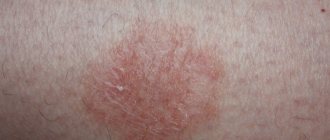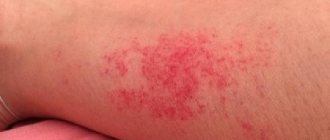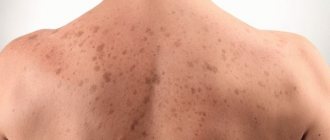Foot fungus is a common disease that requires immediate medical attention. It is characterized by the frequency of unpleasant sensations when walking and manifests itself externally.
Foot fungus is one of the most common diseases
At the first signs of fungus, you should visit a dermatologist who will conduct a diagnosis to find out the cause of the infection - a specific fungus.
According to statistics, up to 70% of the world's population have been infected with fungal infections, including candidiasis and onychomycosis, at least once in their lives. Children suffer less often than adults, and men over 60 suffer more often than women.
More useful information about treating foot fungus in children can be found here.
Causes of foot fungus
It is easy to catch foot fungus when visiting public places with high humidity.
People who neglect the rules of personal hygiene are susceptible to foot fungal infections. Dermatologists often diagnose the disease in patients who regularly visit public places where there is high humidity. It is in such areas that the fungus lives, since here ideal conditions for development and reproduction are created for it. Therefore, there is a high risk of infection with the pathogen in swimming pools, saunas, baths and showers in gyms. It dies only during prolonged boiling in water heated to a critically high temperature.
Many men and women become infected with foot fungus in public places when they do not wear slippers and do not follow basic preventive measures. People who try on someone else's shoes or walk barefoot on carpets in public places or at a party are susceptible to the disease.
If a person is infected with foot fungus, then it is potentially dangerous to others. This is because spores of pathogenic microorganisms live in the upper layers of the epidermis, which tends to peel off. Exfoliated skin cells end up in the external environment. The fungus can persist on them for a long time. This is how spores end up on carpets and other surfaces in a home or public place.
It must be remembered that symptoms of infection after infection of the feet do not appear immediately. The first signs of illness make themselves felt after some time. So their absence in the first days after visiting a public place with high humidity does not mean that the person managed to avoid infection.
Risk factors
Lack of personal hygiene greatly increases the chances of contracting a fungal infection of the feet.
Foot fungus is a common disease that can infect adults and children. People who are at risk are most susceptible to it. As a rule, people with weakened immune systems fall into it. It is he who protects the human body from various kinds of pathologies, including mycoses. If the immune system is weakened, it will not be able to protect him from the disease.
The immune system can for a long time restrain the activity of pathogenic microflora, due to which a person develops foot fungus. A minimal disruption caused by mild illness or stress changes this situation for the worse. Negative factors reduce the body's defenses, allowing the fungus to develop active life in the most weakened place.
Fungus on the soles of the feet can appear in a person who is affected by one of the following unfavorable factors:
- Dermatological diseases that are characterized by a chronic course;
- Taking medications that have an aggressive effect on the body;
- Profuse sweating in the legs;
- Frequent experiences of stress;
- Failure to comply with personal hygiene rules;
- Hormonal imbalances.
Avoiding interaction with these factors helps minimize the likelihood of developing mycosis on the foot. Otherwise, a person will have to start looking for a remedy for the fungus that will help cope with the disease and prevent complications.
Lack or insufficient personal hygiene, along with profuse sweating, greatly increases a person’s chances of contracting a mycotic infection. This is because in this way he creates optimal conditions on his body for the propagation of the pathogen. An additional factor that also affects infection is wearing socks made of synthetic material and closed shoes that are too tight.
Hormonal disorders have no less influence on the development of foot fungus . They lead to decreased immunity. This reason explains why teenagers often get this infection. At the time of hormonal changes, they begin to suffer from excessive sweating. Their immune system is temporarily weakened. These conditions are enough to cause foot fungus.
Medicines of certain groups can lead to a decrease in immunity. Antibiotics and corticosteroids are usually to blame. Chronic fatigue, constant stress and disruptions in the functioning of the nervous system are other reasons for the deterioration of a person’s condition. These factors increase the body's vulnerability to various pathogenic bacteria and fungi.
Diseases that increase the likelihood of fungus
Dermatological diseases increase the chances of contracting a fungal infection. These include dermatitis, lichen and eczema. They negatively affect the state of the immune system. In addition, these pathologies create the conditions that are required for the development of fungus on the surface of the skin. Cases of mycosis appearing as a complication of one of the above dermatological pathologies cannot be excluded.
It is very difficult to avoid contracting a fungal infection of the feet in the following cases:
- presence of damage to the skin of the feet;
- wearing tight shoes;
- vascular disease;
- diabetes mellitus;
- presence of ingrown toenails.
Any disorder that leads to problems with blood circulation in the legs negatively affects the state of local immunity in the vulnerable area. And this only increases the chances of contracting a fungal infection.
Risk group
There are also risk groups of people susceptible to fungal infections:
- patients with endocrine disorders (diabetics, patients with thyroid disorders);
- overweight people;
- sweet lovers;
- bottle-fed babies.
Original ideas for decorating windows for the New Year- Salt lamp - do-it-yourself manufacturing technology, operating principle and selection tips
How to wash a felt-tip pen or marker - tips and methods for quick removal from various surfaces (110 photos)
Types of diseases and their symptoms
Few people know what the fungus that develops on the foot looks like. To have an idea about this disease, it is enough to familiarize yourself with its symptoms. There are several forms of foot fungus, which differ from each other in clinical picture.
Doctors name a number of symptoms that are common to all types of foot fungus. Among them, itching and burning in the infected area stand out. Patients also experience peeling of the skin, falling off of its particles and irritation of the epidermis. Based on these signs, patients and doctors suspect the development of a fungal infection on the legs.
Interdigital dermatophytosis
Symptoms of a fungal variety of feet - interdigital dermatophytosis
This form of pathology is considered the most common. During its course, the fungus is found mainly between the 4th and 5th toes. The disease is recognized by cracks that appear in the affected area. If the patient suffers from the wet form of the disease, then the skin looks swollen. When dry, peeling and falling off of its particles that were susceptible to infection are observed.
Quite often, interdigital dermatophytosis is accompanied by the development of a bacterial infection, which attaches during the activation of pathogenic microflora on the foot. The disease becomes advanced very quickly if you don’t start fighting it. At this point, the symptoms of mycosis intensify. The patient constantly experiences severe pain, which is almost impossible to get rid of.
Moccasin-like shape
This type of disease is also called “athlete’s foot.” The disease has a severe course. Its development is caused by incorrect therapy or its complete absence. With this lesion, the nail plates are affected. They change their usual shade to black, yellow or blue. Also, nails lose their natural transparency. As the disease progresses, they simply crumble and crumble, and their surface is greatly deformed.
Signs of this form of the disease include peeling of the foot and its covering with scales. They are localized on the sides. The skin of the sole peels off, and the skin covering it becomes horny. In appearance, the leg begins to resemble a moccasin.
Vesicular (ulcerative) form
This form of the disease is not as common as other types of foot fungus. It is characterized by the appearance of rashes in the infected area, inside of which there is a cloudy liquid. These blisters are located over the entire surface of the foot. Periodically, they burst, resulting in the formation of painful ulcers in their place.
Additional signs of a fungal disease include unbearable itching, separation of the skin, finger diseases, as well as burning and peeling of the epidermis. Patients with this diagnosis experience swelling of the feet. An increase in body temperature cannot be ruled out.
The easiest way to cope is with vesicular pathology, since the pathogens that cause it are localized on the surface layers of the skin. The rest of the fungus is contained in the blisters. Only the addition of a bacterial infection can delay the treatment process.
Some types of onychomycosis
Depending on the degree of spread of the disease, its forms are distinguished.
- Lateral onychomycosis is the most common. A small yellow spot first appears on the free edge of the nail. In the future, you will notice how it increases, and the nail plate thickens. While walking, a person feels discomfort. The spread of an unpleasant odor is noticeable. Lateral onychomycosis is difficult to treat.
- Superficial onychomycosis is characterized by damage to only the upper layers of the plate. It does not thicken, but over time it becomes chalk-like.
- The rarest form of the disease is subungual onychomycosis. The skin thickens noticeably in the nail fold. The nail turns white and loses its transparency.
Appearance of different forms of onychomycosis
Why is mycosis of the foot dangerous?
Fungal infection of the foot is one of the dangerous conditions that cause significant harm to the health of the infected person. With the development of this pathological process, serious complications often arise. The body is not able to prevent such a course of events, since it is not able to cope with the attack of aggressive pathogens due to an overly weakened immune system.
Any scratch in the affected area does not heal for a long time due to fungus. If you do not care for it correctly, the likelihood of a secondary infection increases. Patients with this disease often develop eczema and dermatitis, which greatly delay the course of treatment for mycosis of the feet.
Patients may suffer from allergic reactions on the skin, which are caused by the products of their active life activity left behind by fungi.
A fungal infection causes irreparable harm to a person, as it has the ability to penetrate into the slightest cracks in the feet. Mycoses also provoke the formation of warts on the infected site, which can only be removed by surgical methods.
Family illness
Very often, intra-family transmission of the disease occurs when sharing shoes, towels, washcloths, rugs and bars in the bathroom with the patient.
If one of the family members suffers from onychomycosis, it is necessary to treat the bath with soap suds and a chlorinated solution; do not share shower racks and mats (especially wooden ones) with the sick person; keep shoes in a separate place from the sick relative and ask him not to wear shoes that are not his own.
See also: Antifungal agents →
Diagnostics
A professional dermatologist will be able to identify which pathogen caused the lesion on the feet
A dermatologist treats fungal infections of the feet. It is to him that you should go for an appointment if you suspect the development of this disease. If necessary, he will redirect the patient to another specialist if additional consultation is required, simplifying the diagnosis and selection of therapy for the infection.
The doctor will talk with the patient about his complaints and carefully examine the infected feet. Afterwards, he will prescribe a series of tests that will help determine the causative agent of the disease and its sensitivity to individual medications. Patients usually undergo the following tests:
- Microscopic diagnostics, which involves treating biomaterial taken from a patient with potassium hydroxide;
- Examination of fabric using a Wood's lamp;
- Inoculating biomaterial on special media intended for fungal growth.
After carrying out all the necessary diagnostic measures, the doctor will be able to say exactly which pathogen caused the damage to the skin of the feet.
Treatment methods
Treatment of fungal infections of the feet is prescribed by a competent specialist. Only in this case can you count on a positive outcome from completing the full course of therapy. It itself is based on several principles:
- Conducting the fight against the pathogen. At an early stage of pathology development, patients are prescribed topical medications. Creams and ointments help defeat pathogenic microorganisms. If the case is advanced, then additional systemic medications are prescribed in the form of capsules or tablets;
- Increasing immunity and improving blood circulation in the affected area. Such actions have a positive effect on the outcome of treatment;
- Implementation of desensitizing therapy. Mycosis of the feet is often accompanied by allergic reactions. To eliminate them, you need to take certain medications that improve the general condition of a person.
If the course of treatment proposed by the doctor is based on these principles, then it will bring a positive result.
External means
Local preparations designed to get rid of mycosis of the feet by applying them directly to the lesions have the least impact on the body. The patient will learn how to get rid of the fungus with their help during a visit to a specialist who is prescribed this therapy.
Local medications are effective in the initial stages of development of mycosis of the feet. They are most useful when used as part of complex treatment.
Gels, ointments and creams should be applied only to cleansed and dried skin. They are rubbed in with massaging movements. This procedure is usually recommended to be carried out within 7-10 days. The treatment must be applied not only to the problem area, but also to neighboring tissues to prevent them from becoming infected with fungus.
There are a variety of topical treatments for foot fungus available for adults and children. If therapy for a child’s leg is required, then the choice of the appropriate medication must be entrusted to a competent specialist, since not all drugs presented by modern pharmaceutical companies are suitable for young patients.
The following topical medications help to cope with fungal infections of the feet:
- "Lamisil" cream;
- "Clotrimazole";
- "Mikozolon";
- "Nizoral";
- "Nitrofungin";
- "Ketoconazole";
- "Fetimin";
- "Exoderil".
Before using the drug, you must carefully study its instructions for use. It is also necessary to agree with the attending physician on the duration of treatment with the prescribed local remedy.
Pills
If the legs are affected by a fungal infection, medications are prescribed
It is not always possible to cure mycosis on the foot with local remedies alone. A specialist knows how to fight the fungus in this case. In complicated and advanced forms, the inclusion in the therapeutic course of systemic medications that are intended for oral administration is required. The selection of a suitable drug should be carried out after the physician determines the type of infectious agent and its sensitivity to the active substances. It also takes into account whether the patient has certain contraindications to treatment with one or another drug.
In most cases, for fungal infections of the feet, the following systemic drugs are prescribed:
- "Lamisil";
- "Diflucan";
- "Organal".
The use of systemic drugs for medicinal purposes is contraindicated in patients who have impaired renal or liver function. They are also prohibited for pregnant and lactating women. The group of contraindications also includes hypersensitivity to the active component of the drug.
Folk remedies
Traditional methods help alleviate the patient's condition and reduce the severity of symptoms of the disease. The following alternative medicines show good results in the treatment of fungal infections of the feet:
- Salt baths. They are prepared from 1 liter of hot water and 1 tsp. coarse salt. It is recommended to steam infected feet in the resulting solution for 15-20 minutes;
- Compresses with hydrogen peroxide. The antiseptic requires thoroughly moistening the cotton pad. Afterwards it is applied to the infected area of the leg for 1 hour. Repeat this procedure 2-3 times a day;
- Ointment with tree resin. The sifted raw materials must be mixed with fat. The result of this combination should be a fairly thick mass. It must be applied to fungal-affected areas of the legs twice a day.
It is best to use folk remedies as adjuvant therapy to enhance the effect of the medication course.
Hardware treatment of fungi
Hardware therapy is well suited for treating feet that are often infected with fungus
In some cases, doctors recommend that their patients with foot fungus agree to hardware therapy. Such measures are required if the mycelium grows too quickly, which is why medications do not have time to suppress its activity. Laser correction helps to cope with the disease in such a situation. The specialist burns the mycelium with a beam. After such exposure, the patient feels relief, as he is no longer bothered by the symptoms of infection.
Laser correction is suitable for treating feet and nail plates, which are often infected with fungus. The beam simply dries out the spores and creates conditions at the site of the lesion that are unsuitable for the normal functioning of the infectious pathogen.
After laser correction, the patient will have to take medications that will help achieve a full recovery.
It must be taken into account that hardware therapy does not provide a guaranteed positive result if the patient neglects hygiene rules and refuses to take medications with antifungal action.
General rules during treatment
The key to successful treatment of foot fungus is compliance with the general rules of care for affected limbs, shoes and other items that may be susceptible to infection.
All patient shoes must be disinfected, since infectious agents may remain in their inner surface. The same goes for socks and other wardrobe items. It is recommended to treat them with special sprays containing chlorhexidine or formaldehyde. Many compositions that differ in antimicrobial action are suitable for this purpose.
Throughout treatment, the patient should follow a diet that excludes the consumption of large amounts of sugar. You should also avoid wearing decorative nail polish. Instead, it is recommended to use iodine or another antiseptic of this type.











